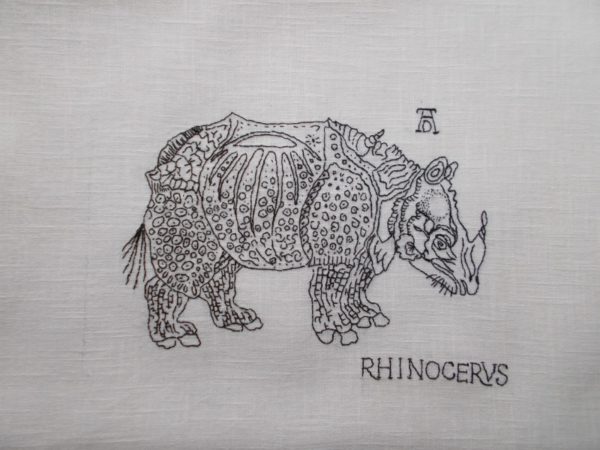
Rhinoceros in Blackwork after a woodcut of 1515 by Dürer (hand embroidered by Mary Addison)
I’ve always been much taken by the idea that Tennyson was “ The man who had the extraordinary literary luck to write In Memoriam before Queen Victoria got bereaved and needed it.” (see blog Lynn Truss’s book ‘Tennyson’s Gift’ – a definite for the boudoir shelf and I’m pretty sure the funniest book I’ve ever read.) Well, similarly, Philip Hoare’s ‘Albert and the Whale’ is just the book I needed, before I realised I needed it when I set about embroidering Dürer’s wood cut of a rhinoceros for Daughter No 3’s Christmas present (for 2020).
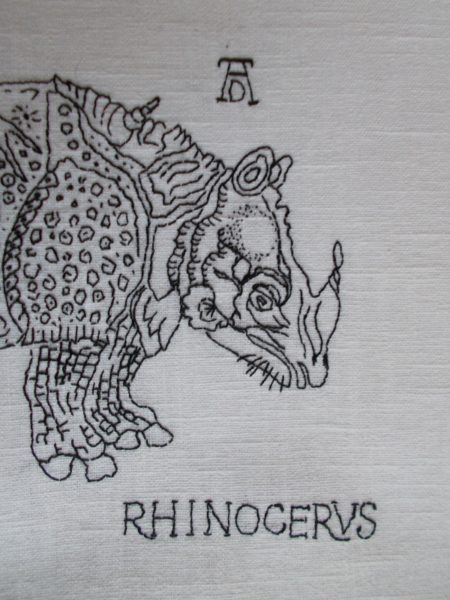
Detail of Rhinoceros in Blackwork after a woodcut of 1515 by Dürer (hand embroidered by Mary Addison)
I finished the embroidery a few weeks ago and almost immediately read a positively Louis XVI golden sunburst of a review of Philip Hoare’s book by Rachel Cambell-Johnston in The Times of 28 February. A brief phone call to our wonderful independent local bookshop, The Suffolk Anthology, had the book ready for collection a few days later (complete with a stamp on my Suffolk Anthology Loyalty Card which is now full and means £10 off my next book purchase there! Goody! ). And now, here I am much better equipped to write a blog post on both Dürer and his rhinoceros woodcut.
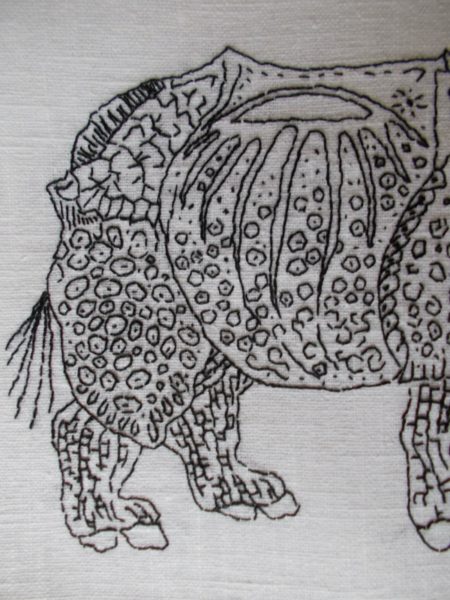
Detail of Rhinoceros in Blackwork after a woodcut of 1515 by Dürer (hand embroidered by Mary Addison)
Tales of strange beasts, both real – like giant sea mammals, the whales, narwhals, etc – and imaginary, set Dürer’s heart racing. The whale of the title of Hoare’s book had caused much consternation when it washed up on the westernmost reaches of watery Zeeland. Dürer, determined to see it, and self challenged to depict it, set about an adventure, trekking through soggy, rain-soaked landscapes and battling with storms at sea to witness for himself the dead, beached creature. All in vain, he got there too late – a voracious tide had taken a grip of the giant corpse and wrestled it back out to sea. Dürer never did see a whale but he returned home, imagination newly fired up – bereft of the reality of the whale but alive to the possibilities of what was out there. Fascinated equally by the myths and legends of the Medieval world he was rooted in and the new science and discoveries of the future – “Janus-faced Dürer” as Rachel Campbell-Johnston calls him.
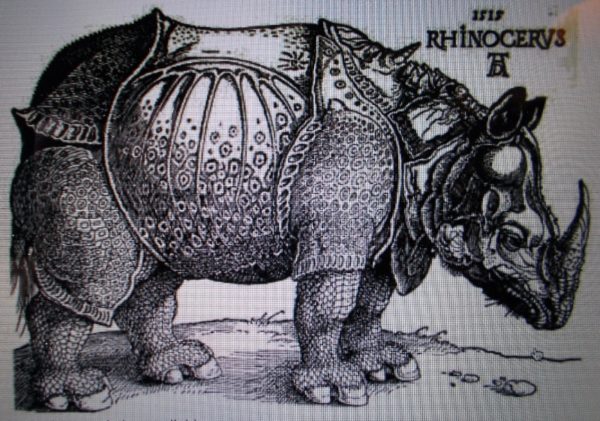
Dürer’s Rhinoceros
In 1515 Europe was excited by the first rhinoceros to set foot on European shores since Roman times. Named Ganda, from its name in Gujarati, it was a present from the Sultan of Cambaia in NW India to the Portuguese ambassador who didn’t seem to know quite what to do with such a gift, so sent it on a journey of 120 days half way around the world (via the Cape of Good Hope) to his king, Manuel I, in Portugal. Manuel himself had no better idea of what to do with Ganda and instead of letting the creature BE and DO nothing he organised a fight between Ganda and a young elephant from his menagerie, ostensibly to test Pliny the Elder’s assertion that the elephant and the rhinoceros are natural enemies. This test was a failure as the elephant, surprised by the strangeness of Ganda emerging from under a mound of carpets and unused to the noise of the crowd, fled before fighting could begin (hooray!). Still perplexed by his strange present, Manuel did what many of us do with unwanted Christmas bounty and re-gifted it. Manuel liked to send very special presents to the Pope, Leo X, to keep him sweet and to distract him from thoughts of all those ‘new’ lands in SE Asia ‘discovered’ by Portugal. Now, the previous year Manuel had sent the Pope a white elephant, which had gone down very well. Perhaps Ganda would continue that winning streak, so back on a boat the beast went. Unfortunately, there was a terrible storm at sea and the rhinoceros, chained and shackled to the deck, went down with the boat. Once again, Dürer had missed his beast.
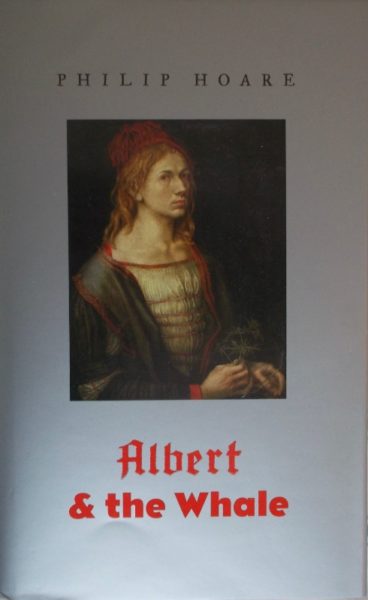
Philip Hoare: Albert & the Whale (pub. 4th Estate 2021)
Nuremburg, Dürer’s home town, had trading agents in Lisbon when Ganda arrived and they sent reports home. One newsletter included a sketch of the beast and from this Dürer made a pen and ink drawing. Flying in the face of the facts and with his head full of stories from Aristotle and the C13th monk Albertus, he made a creature, in all except bodily shape, almost completely a thing of his own imagination. Yet, on the back of the woodcut Dürer wrote the following untruth, “This is an accurate representation. It is the colour of a speckled tortoise and is almost entirely covered by thick scales. It is the size of an elephant but has shorter legs and is almost invulnerable. It has a strong pointed horn on the end of its nose which it sharpens on stone…” In truth it was no accurate depiction. Indian rhinos do have folds of skin that from a distance look like discrete plates of thickened skin and some rhinos have wart like bumps but neither features are pronounced to the point of resembling armour, metalworked designs nor scales. It is also possible that poor Ganda may have suffered from skin imperfections caused by an inadequate diet or insufficient exercise during those 120 days at sea but no skin imperfection would look quite so regular or artistic. No, the conclusion is as irresistible as the creativity Dürer put into his drawing – such ornamentation was born of his imagination not reality. And inaccuracy was no obstacle to publication. Not only was Dürer’s image the go to one for many eminent naturalists’ texts but, until the 1930s the image also appeared in school textbooks in Germany as a true likeness!
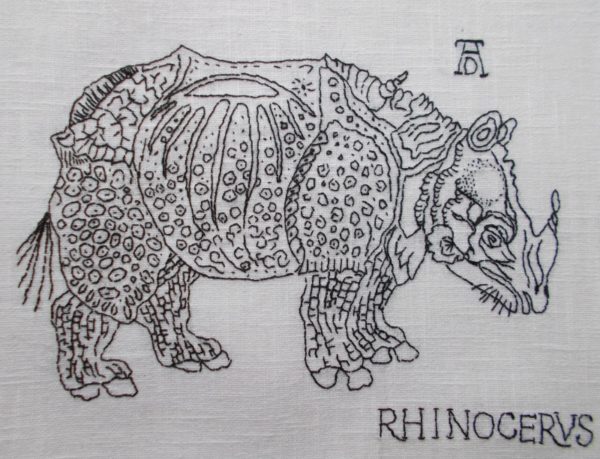
Rhinoceros in Blackwork after a woodcut of 1515 by Dürer (hand embroidered by Mary Addison)
The fact is we all love the image – and perhaps even wish rhinoceroses looked a bit more like it. Just as Dürer departed from the sketch sent by a Nuremburg trader, so I have departed from Dürer’s woodcut – though more out of necessity than imagination in my case.

Rhino (hand embroidered by Mary Addison)
An embroidery of a C16th woodcut of a rhinoceros isn’t everybody’s cup of tea, but I’m quite sure it’s a good present for Daughter No 2 because when I did these embroideries of rhinos here, (and also above and below) she reminded me that she still expected an embroidery of Dürer’s beast as well. What surprised me was how much I really enjoyed sewing it – in just black thread and with a lot of leeway as to Dürer’s decorative detail. The whole thing was greatly helped by the use of Magic Paper which not only enables you to draw in pencil (on the Magic Paper which disappears when washed) but which also acts as a stabiliser while embroidering, so there’s no puckering and no need to use a hoop (which I dislike). Embroidery is made even easier because the ‘fabric’ of the Magic Paper is more tightly ‘woven’ and smoother than most of the linens I’ve been embroidering on, so the resulting embroidered line is more true to the drawing than it would be if embroidering directly on to slightly knobbly, textured linen. I love it – and so I won’t run out soon (it comes from DMC in France), my husband bought 15 packets (two A5 sheets per packet).
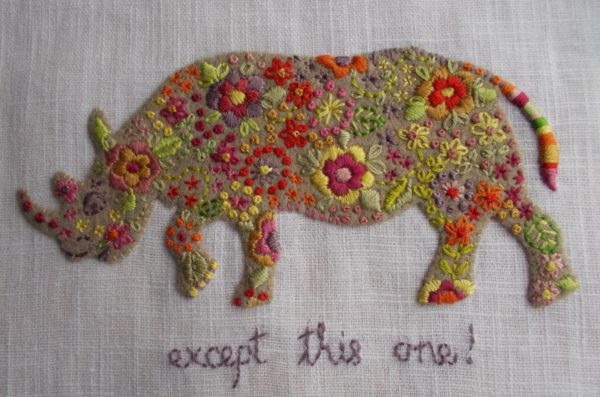
Rhinoceros (hand embroidered by Mary Addison)
Philip Hoare’s book, a tour de force is more that a biography of Dürer, being an eclectic mix of literary sleuthing, historical and contemporary travel writing and references to more erudite texts than I can absorb at one reading. It is also a personal memoir of the writer, his interests and even his ailments. It reminds me of W.G.Sebald’s The Rings of Saturn and also of Alain de Botton’s How Proust Can Change Your Life and I know from experience that you either like this genre of books or you don’t – I am enjoying it but I am finding some of the lines of thinking in Hoare’s book a little difficult to follow – perhaps reading in bed just before sleep isn’t the best place for books like this! As with Patchwork. A Life Amongst Clothes by Claire Wilcox, mentioned a few weeks ago I wonder whether this sort of writing hasn’t become a bit too precious and inscrutable. I would prefer to find the author appear more clearly in their writing so that I don’t have to constantly keep going back in the book to make sure I haven’t missed some vital detail that makes everything else clear and fall into place. I wonder what others think.

6 Comments
There is a biography about an east coast fisherman who took to embroidering his pictures which was so full of the biographer’s life that I became confused…!
I like your rhinos. And your version of Durer’s is a real treat!
Yes, you mean Julia Blackburn’s ‘Threads:The Delicate Life of John Craske’, don’t you? People either loved it madly or were v. irritated by it. I have the book but have never got round to reading it. There seems to be a delight in making the reader work hard at identifying who is being talked about at any given moment – a bit of crossover is ok but too much and the whole thing screams artifice and confusion until the writer just loses the reader’s interest. I think such writing is on the increase which is pretty woeful!
Thank you for saying you like the rhinos.
Yes, I couldn’t remember anything that would help me look it up! Worth reading, I think, but be aware of potential confusion!
Rachel, thank you for reminding me about the book which I had already forgotten about!! I shall get it off the shelves immediately and put it somewhere really visible for the time when I come to the end of a series of novels on crime in the art world.
I love your rhino pictures but the story of the poor beast being passed around and finally debilitated to death is so sad. Humans can be so horrible.
ceci
The exotic is so relative and humans have done many inglorious things with creatures that we have made into little more than exhibits. It’s at least good that Dürer’s woodcut of the rhino has made the animal better remembered than it would otherwise have been.
On the other hand, we often feel the earth has been explored to death – possibly nearly literally to death but then you read about all the previously unknown sea creatures living deep in the deepest parts of the ocean and you can imagine a little of how strange a rhino might have been to early C16th people.